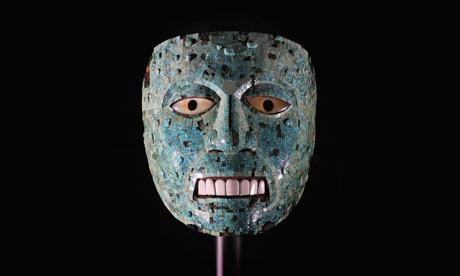 A rare turquoise mosaic mask from the Aztec exhibition at the British museum. Photograph: Dan Kitwood/Getty Images
A rare turquoise mosaic mask from the Aztec exhibition at the British museum. Photograph: Dan Kitwood/Getty ImagesMaev Kennedy
The Guardian, Wednesday 8 April 2009
The Aztec emperor Moctezuma was murdered by his Spanish captors, not by his own people, it will be argued in a new exhibition attempting to rescue a shadowy figure from the propaganda that portrayed him as a traitor.
- Moctezuma: Aztec Ruler
- British Museum,
- London
- WC1B 3DG
- Starts 24 September
- Until 24 January 2010
- Details:
020-7323 8181 - Venue website
The exhibition, at the British Museum, will challenge the traditional account of how the ninth and last great elected Aztec emperor met his end in 1520.
In 1519, a small Spanish army led by Hernando Cortés landed in the Aztec empire. They were initially received with friendship by Moctezuma, a renowned warrior who had ruled as emperor since 1502. The accepted version of events has the Spanish inside his capital, Tenochtitlan, by 1520 holding the emperor as a willing hostage. When he tried to quell a rebellion, the story goes he was stoned to death by his own people.
The truth, the British Museum will suggest, is that the hero who had received the Spanish with honour became a prisoner, and was murdered when he was no longer of use. The exhibition - giving the emperor's name as Moctezuma, closer to the original Aztec than the more familiar Montezuma - will display together for the first time two 16th-century manuscripts, one from Mexico and one owned by Glasgow University, which challenge the traditional account. Tiny figures among a wealth of detailed illustrations of the first encounters between Aztecs and Spaniards have only recently caught scholars' attention: both manuscripts, almost certainly by central American artists, show Moctezuma shackled or with a rope around his neck.
Almost all the written accounts are from decades later, serving one side or the other. Cortés did send dispatches - justifying his actions and stressing the treasure he would be sending - but the reports from a man regarded as a near-outlaw by the Spanish court are considered no more trustworthy than the later stories. Several Spanish accounts refer to Moctezuma as noble and dignified, and mourned by the Spanish. They promptly formed alliances with enemy neighbouring kingdoms resentful of having to pay lavish Aztec tributes.
Moctezuma's supposed death at the hands of a mob is portrayed in paintings from Madrid, inlaid with mother of pearl, included in the exhibition. One Spanish account even insists he refused medical help and food from his Spanish captors, who "spoke very kindly to him". However another account says Cortés killed him by pouring molten gold down his throat.
Moctezuma's reputation is still contentious in Mexico, according to the British Museum director, Neil MacGregor. There is no monument there to him, although there is one to his successor, his brother, who fought on - until he became one of the thousands who died of smallpox and other diseases brought by the invaders.
"What we are trying to do is look at an absolutely key moment in the history of the world through the filter of one man," MacGregor said. "There has never been an exhibition on this man, a great emperor of an extremely sophisticated empire."
The exhibition will bring together spectacular loans from Europe and Mexico, including objects recently excavated from remains of the Aztec city still emerging from under Mexico's modern capital.
Portents such as flaming comets preceded the Spanish, so some accounts suggest Moctezuma wondered if the promised return of the god Quetzalcoatl was imminent. All sides agree he met the invaders courteously, and gave beautiful objects in gold and silver which Cortés promptly melted down. The invaders were astonished by the sophistication of the Aztec capital with its palaces, temples, canals and artificial islands.
"Moctezuma is the last in our series on great rulers and their legacies, and presents perhaps one of the most fascinating examples of implosion of power and the clash of civilisations," MacGregor said.
There was a wealth of personal detail on China's First Emperor Qin, Hadrian the wall builder and the 16th-century Iranian ruler Shah Abbas. But Moctezuma's curator, Colin McEwan, admitted that personal details about Moctezuma are so scarce that one academic thought the exhibition would be impossible.
Modern tests on objects including a spectacular turquoise mask show that the gold, precious stones and feather decorations came from many different places, mapping the breadth of the Aztec empire. "We will raise many questions," McEwan said, "but we may not succeed in answering them all." The exhibition will mark the bicentenary of Mexico's declaration of independence from Spain in 1810, and the Mexican Revolution in 1910.
No hay comentarios:
Publicar un comentario